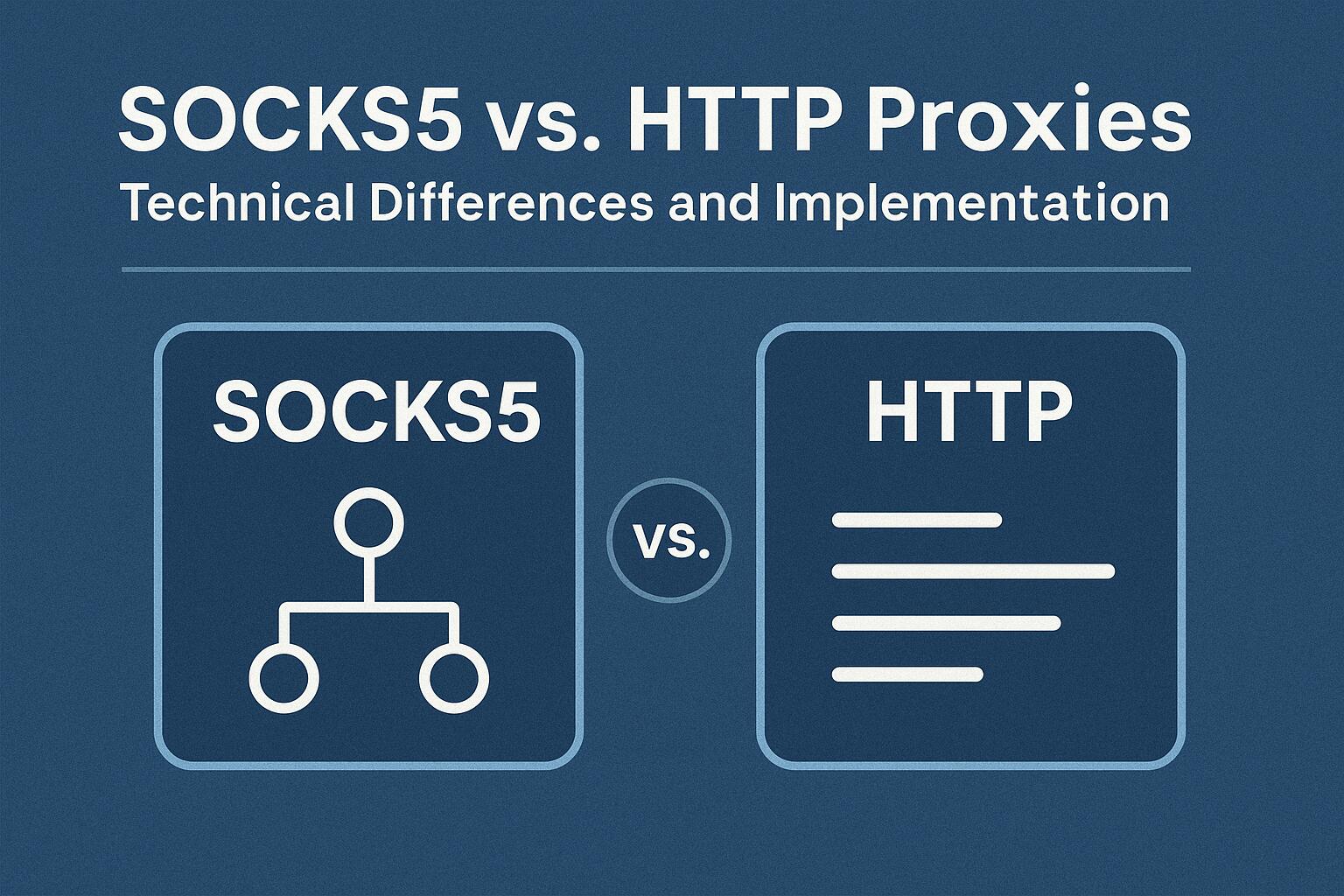Proxies are crucial components in modern networking, offering a layer of abstraction between the client and the server. Among the different types of proxies, SOCKS5 and HTTP proxies are two of the most commonly used. While both serve the purpose of routing traffic through an intermediary, they operate at different layers of the OSI model, providing different functionalities. This article will explore the technical differences between SOCKS5 and HTTP proxies and how they can be implemented.
SOCKS5 Proxy
SOCKS5 is a versatile and advanced proxy protocol that operates at the transport layer (Layer 4) of the OSI model. It is capable of handling any type of internet traffic, including HTTP, FTP, and even UDP, making it suitable for a wide range of use cases. SOCKS5 proxies are known for their flexibility and support for both TCP and UDP protocols.
Features of SOCKS5 Proxy
– **Protocol Support**: SOCKS5 proxies support a variety of protocols, such as HTTP, FTP, and SMTP, allowing for broader compatibility with various types of traffic.
– **Authentication**: SOCKS5 supports multiple authentication methods, providing an additional layer of security by ensuring that only authorized users can use the proxy.
– **No Modification of Data**: Unlike HTTP proxies, SOCKS5 proxies do not alter the data packets. This makes them suitable for applications requiring minimal interference, such as gaming or torrenting.
– **Support for UDP**: One of the main advantages of SOCKS5 over HTTP proxies is its ability to handle UDP traffic, which is essential for real-time applications such as VoIP, online gaming, and video streaming.
SOCKS5 Proxy Implementation Example
Implementing a SOCKS5 proxy in Python can be done using the PySocks library. Below is an example of how to set up a SOCKS5 proxy:
python
import socks
import socket
# Set up the SOCKS5 proxy
socks.set_default_proxy(socks.SOCKS5, “proxy_host”, 1080)
socket.socket = socks.socksocket
# Now, you can make requests through the SOCKS5 proxy
import requests
response = requests.get(‘http://example.com’)
print(response.text)
This script sets up a SOCKS5 proxy using the PySocks library and routes HTTP requests through the proxy. The proxy is hosted at “proxy_host” and listens on port 1080.
HTTP Proxy
HTTP proxies, on the other hand, are specifically designed to handle HTTP/HTTPS traffic. They operate at the application layer (Layer 7) of the OSI model and can filter, cache, and modify web traffic. HTTP proxies are often used in scenarios like web scraping, content filtering, and browsing anonymity.
Features of HTTP Proxy
Protocol Limitations: HTTP proxies are limited to handling HTTP and HTTPS traffic. They are not suitable for other types of traffic like FTP or gaming.
Data Modification: HTTP proxies can modify HTTP requests and responses. This can be useful for caching content or applying filters to web traffic.
Ease of Implementation: HTTP proxies are relatively easier to set up compared to SOCKS5 proxies, making them more common for simple web browsing applications.
Anonymity: HTTP proxies can hide the user’s IP address, but unlike SOCKS5 proxies, they do not provide the same level of anonymity due to the potential for modifying HTTP headers.
HTTP Proxy Implementation Example
Implementing an HTTP proxy in Python can be done using the requests library with a simple configuration of the proxy settings. Below is an example of how to set up an HTTP proxy:
python
import requests
# Set up the HTTP proxy
proxies = {
‘http’: ‘http://proxy_host:8080’,
‘https’: ‘http://proxy_host:8080’,
}
# Make a request through the HTTP proxy
response = requests.get(‘http://example.com’, proxies=proxies)
print(response.text)
This script demonstrates how to route HTTP and HTTPS traffic through an HTTP proxy. The proxy is hosted at “proxy_host” and listens on port 8080.
Technical Differences Between SOCKS5 and HTTP Proxies
The key technical differences between SOCKS5 and HTTP proxies lie in their protocol handling, level of anonymity, and flexibility.
Protocol Handling
SOCKS5: Capable of handling multiple protocols, including HTTP, FTP, and UDP.
HTTP: Only supports HTTP and HTTPS traffic.
Data Modification
SOCKS5: Does not alter data packets; traffic is transmitted as-is.
HTTP: Can modify HTTP headers, requests, and responses, potentially interfering with the integrity of the data.
Level of Anonymity
SOCKS5: Offers better anonymity as it operates at a lower level and does not modify data.
HTTP: Provides less anonymity, as it modifies headers, which can reveal information about the user.
Traffic Handling
SOCKS5: Handles both TCP and UDP traffic, making it suitable for applications like gaming, VoIP, and torrents.
HTTP: Limited to handling only HTTP/HTTPS traffic.
Conclusion
Both SOCKS5 and HTTP proxies serve important roles in different networking scenarios. While SOCKS5 proxies offer more flexibility, security, and anonymity, HTTP proxies are better suited for simple web browsing and caching scenarios. Understanding these differences and implementing the right type of proxy can have a significant impact on the performance and security of your network applications.
We earn commissions using affiliate links.




![Best Socks5 Proxies 6 BEST Socks5 Proxies 2024 [Residential & Private]](https://www.privateproxyguide.com/wp-content/uploads/2020/08/best-socks5-proxies-150x150.jpg)
![BitTorrent vs uTorrent [year] – Key Differences & Best Choice BitTorrent vs uTorrent 2021](https://www.privateproxyguide.com/wp-content/uploads/2019/02/bittorrent-vs-utorrent-150x150.jpg)
![VDI vs VPN vs RDS [year] Key Differences Explained VDI vs VPN vs RDS](https://www.privateproxyguide.com/wp-content/uploads/2022/01/VDI-vs-VPN-vs-RDS-150x150.jpg)


![Ghost Proxies Review: Secure and Fast Proxy Solutions [year] Ghost Proxies Review](https://www.privateproxyguide.com/wp-content/uploads/2017/11/ghost-proxies-150x150.jpg)